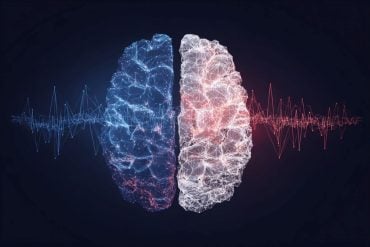Summary: New research reveals a distinct brain activity signature in children who become overwhelmed by sensory input such as noise, touch, or bright lights. Using functional MRI, scientists found that overly sensitive children show reduced activation in outward-facing sensory and motor networks while increasing activation in inward-focused networks tied to cognition and impulse control.
This compensatory shift appears to help them manage emotional overload but also contributes to strong behavioral reactions. The results suggest that understanding each child’s unique neural pattern could guide more personalized and effective sensory therapies.
Key Facts:
- Distinct Neural Pattern: Over-responsive children display reduced sensory–motor network activity paired with heightened inward-focused cognitive network activity.
- Opposite in Less Sensitive Kids: Children who are not overwhelmed show the reverse activation pattern, indicating different neural strategies for processing input.
- Therapeutic Potential: Mapping these patterns may help clinicians tailor sensory interventions for children with sensory-induced emotional and behavioral challenges.
Source: UCSF
In the search for a way to measure different forms of a condition called sensory processing disorder, neuroscientists are using imaging to see how young brains process sensory stimulation.
Now, investigators at UC San Francisco have found a distinctive pattern for overwhelm in some children who are overly sensitive to sound, touch, and visual information. The finding could one day help clinicians refine treatments for kids who have strong emotional and behavioral reactions, such as tantrums, to their sensory environment.
Sensory processing disorder affects how the brain understands and responds to sensory information but still lacks an official medical diagnosis.
The study, which was funded by the National Institutes of Health (NIH), appears in the Journal of Neurodevelopmental Disorders on Nov. 21, 2025.
Researchers at UCSF studied 83 neurodivergent children between the ages of 8 and 12 years old. About half were highly sensitive to certain noises, lights, or tactile sensations, while the other half weren’t.
When scientists imaged their brains using functional MRI, which measures brain activity by detecting changes in blood oxygenation levels, they found significant differences between the two groups.
For over-responsive children, the activity in brain networks that govern so-called “outward” functions, such as motor skills and sensation, was low, while the activity in brain networks that regulate “inward” functions, like cognition and impulse control, was high. This was exactly opposite of the pattern that scientists observed in the less sensitive children.
“We think that when you are overstimulated by sensory input, you compensate by dialing up your brain’s inward-focused networks to gain self-control. You also dial down your outward-focused networks to minimize sensory input,” said Pratik Mukherjee, MD, PhD, a UCSF neuroradiology professor and co-senior author of the study with Elysa Marco, MD, a pediatric neurologist.
“The kids who aren’t emotionally overwhelmed by the input — some are even under-responsive to it — do the opposite.”
Past research indicates 5% to 12% of children in the U.S. have sensory processing challenges, and this may explain much of the emotional volatility in the school-age population.
Treatment for over-responsive children often focuses on gradually exposing them to sensory input over time so they learn to tolerate it.
Mukherjee said the team’s findings could help improve these therapies: “If we know an individual child’s brain patterns and how that maps to emotion and behavior, we may be able to use this to personalize treatments.”
Funding: The National Institutes of Health (5R01MH116950‐04).
Key Questions Answered:
A: Lower activity in outward sensory–motor networks and higher activity in inward cognitive-control networks.
A: Less sensitive children show the opposite pattern, engaging outward networks more strongly.
A: Individual brain patterns may help clinicians tailor sensory therapies to each child.
Editorial Notes:
- This article was edited by a Neuroscience News editor.
- Journal paper reviewed in full.
- Additional context added by our staff.
About this neuroscience and neurodevelopment research news
Author: Jess Berthold
Source: UCSF
Contact: Jess Berthold – UCSF
Image: The image is credited to Neuroscience News
Original Research: Open access.
“A neural substrate for sensory over-responsivity defined by exogenous and endogenous brain systems” by Elysa Marco et al. Journal of Neurodevelopmental Disorders
Abstract
A neural substrate for sensory over-responsivity defined by exogenous and endogenous brain systems
Background
Exogenous (outward-directed) and endogenous (inward-directed) neural systems are essential for cognition and behavior. However, how they are altered in neurodiverse (ND) children remains unanswered in part due to heterogeneity.
Sensory over-responsivity (SOR), the most prevalent form of sensory processing disorder (SPD), serves as a quintessential paradigm for investigating the interaction between exogenous and endogenous brain networks given that both basic and higher-order sensory processing are substantially implicated in this condition.
Methods
Neurodiverse children ages 8–12 years old (n = 83; 30 females and 53 males) were directly assessed for SOR using a structured clinical evaluation, the Sensory Processing 3 Dimensions Assessment (SP3D:A), and underwent 3 Tesla MRI. 39 ND children presented with SOR (ND/SOR) and 44 ND children presented without SOR (ND/NO-SOR).
Exogenous and endogenous functional connectivity networks (FCNs) were generated through independent component analysis and investigated with two local functional connectivity (FC) measures, fractional amplitude of low-frequency fluctuations (fALFF) and regional homogeneity (ReHo), as well as a long-range FC measure, dual regression (DR).
Moreover, we examined FC in the context of behavioral regulation as assessed through the Behavioral Assessment System for Children, 3rd edition (BASC-3), categorizing children as “resilient” or “dysregulated” through latent profile analysis.
Results
In general, ND/SOR children exhibit reduced long-range exogenous FC. However, in terms of local FC, we find that ND/SOR children have reduced exogenous and elevated endogenous FC which is diametrically opposed to ND/NO-SOR children. Furthermore, this double dissociation is specific to ND children who are behaviorally resilient, while emotionally dysregulated ND children possess a distinct pattern.
Conclusion
Achieving optimal brain system connectivity—a balanced contrast—is influenced by sensory over-responsivity and essential for resilience.







